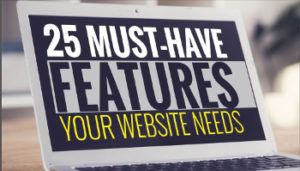 When was the last time you updated your website or did an audit of its features? A good website must evolve with the times. Research shows that the average web user will wait only about six seconds for a page to load, and has minimal patience for things like complicated navigation or broken links. It’s your responsibility to do what you can to ensure that visitors to your website have a smooth and enjoyable experience that will encourage them to visit again – or to come to your physical location and make a purchase.
When was the last time you updated your website or did an audit of its features? A good website must evolve with the times. Research shows that the average web user will wait only about six seconds for a page to load, and has minimal patience for things like complicated navigation or broken links. It’s your responsibility to do what you can to ensure that visitors to your website have a smooth and enjoyable experience that will encourage them to visit again – or to come to your physical location and make a purchase.
With that in mind, here are the 25 must-have features that you need on your website.
Let’s start with the home page:
- An easy-to-remember domain name. Your domain name should be as close as possible to the name of your business.
- An attractive and compelling logo that includes your business name and is relevant to what you do.
- A short tagline that lets people know what your business does. The ideal tagline should have no more than ten words and give people a clear idea of who you are.
- A strong image above the fold. Nobody wants to click on a website and see a wall of text. What you have on your website should be a combination of text and graphics, and it’s very important to start off with a striking image (or images on a carousel) that will draw people in and engage them.
- Top navigation. The most common site for navigational tools is across the top of your website. You don’t want visitors to your site to have to guess how to get from your home page to your store, or from your blog to your home page.
- A search function in the upper right-hand corner of the page. Menu placement is important, but some people who visit your site are going to want to search and you need to make it easy for them to do so. You should also plan on including a search function on your blog page.
- Bread crumb navigation on every page. Bread crumb navigation allows users to return to your home page at any time. You can have a link to your home page or, as many companies do, turn your logo into a hyperlink that will return visitors to your home page if they click it.
- Key information about your business, including your full name, street address, telephone number, and hours of operation. You may also want to include a map.
- Customer testimonials or reviews. More than 80% of all internet users say that customer reviews and testimonials play a crucial role in their buying decisions. You should have at least one written (or video) review or testimonial on your home page with a link to a dedicated page where users can find additional reviews.
- A call to action. You may end up having more than one of these, but it’s a good idea to have your first one above the fold (meaning before a user has to scroll down) on your home page. It might be a link to download a lead magnet, call your business from a mobile device, or sign up for a free consultation. Whatever it is, it should be easy to see. Contrasting or complementary colors are a good choice to make it stand out.
- Main features of your business. You should include an overview of your products, services, features, and other distinguishing characteristics of your business. You want your home page to give visitors a solid picture of what you do.
- Quality content. Any written content on your home page (or on any interior pages, for that matter) should be written for people first and then for search engines. Use keywords by all means, but remember that your most important visitors are customers, not search engine spiders.
- Internal links in your content. Internal links may lead customers to more detailed write-ups of your services, or to your online store.
- Social media follow buttons. If you want to build your social media following, you should have buttons for all of your accounts (Facebook, Twitter, Pinterest, Instagram, and so on) in the footer of your home page.
Now let’s look at some must-have features for your interior pages:
- A contact page with an easy-to-use contact form and a Captcha to help avoid spam. Even if your contact information is on your home page, you need to have a dedicated contact page, too.
- A personalized “About Us” page. People who visit your site want to know about you. The “About Us” page is where you can share the history of your company, brief biographies of yourself and your staff, and your vision for your business.
- A “Frequently Asked Questions” page that addresses common questions and concerns and clarifies what you do. Your FAQ page doesn’t need to be long, but it should be as comprehensive as possible. It’s also a good idea to have a link to a contact form for customers who can’t find what they’re looking for on the FAQ page.
- A page featuring your privacy policy. This is a legal must for every business. In most cases, you can use boilerplate language but don’t skip this step.
- A blog page. Blog entries don’t need to be long, but they really are essential if you want to use content marketing as a way of attracting new visitors to your site.
- Content in an “F” pattern. Research shows that most internet users read content in an “F” pattern, meaning that they tend to read the first line or two all the way across the page and then skim down the left-hand margin. They may read across if you have a subheading, but you want to make sure to use plenty of white space to make your content as easy to read as possible.
Other pages:
- Social sharing buttons on every blog pos The whole point of having a blog is to get people to visit your site. One way you can do that is to enable social sharing so that the people who read and enjoy your blog can share it.
- Comment section on every blog post. People who read blogs like to leave comments and questions. Make sure you have a comment section and monitor it regularly.
Design features:
- A clear, easy-to-read font. If you want to use a fancy font for your logo or headline, you can certainly do so. However, keep it to a minimum. The majority of your site should be in a 14-point Sans Serif font.
- A mobile responsive design. More people search online with mobile devices than with computers. That means your site must be mobile responsive if you want mobile users to visit it.
- Easily recognizable links. Readers shouldn’t have to guess which text is hyperlinked and which isn’t. Your links should be in a color that stands out from the rest of your text.
Of course there are other technical elements and design features that you may want to include, but these 25 will ensure that you get off to a good start and provide visitors to your site with what they need.
For more great articles, Subscribe to our FREE monthly Magazine HERE
